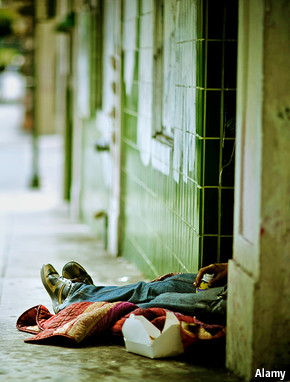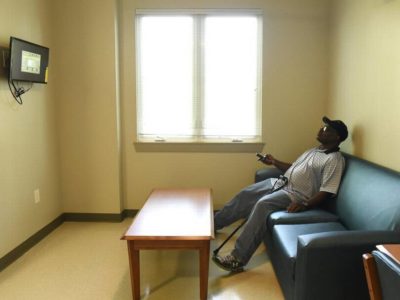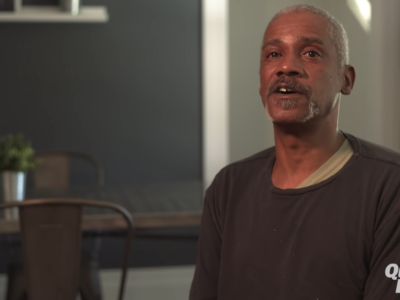
Handing a homeless alcoholic the keys to a free furnished flat may seem foolish, unfair or both. That was certainly what Ted Clugston, the mayor of Medicine Hat, a Canadian town of 61,000, used to think—but experience has changed his mind. No-strings housing offers have helped bring the town within sight of a goal it set itself five years ago: to end homelessness by 2015. At the time over 1,000 people passed through its homeless shelters each year, many between spells on the street. If the municipality succeeds, it will be the first in North America to do so.
Most of the long-term homeless are mentally ill, alcoholic or drug-addicted, often all three. The standard way to help them has long been the “staircase” approach: requiring them to quit drink and drugs before shepherding them through emergency shelters and temporary lodging until they are deemed ready to be housed. But many refuse to sign up. Those who do often fall off the wagon. Typically, fewer than half make it all the way to a (usually subsidised) permanent home.
In 1992 Sam Tsemberis, a professor of psychiatry at New York University, started a programme that turned that sequence on its head. Pathways to Housing gave rough sleepers furnished flats in poor districts. Medical care, treatment for addiction and help in learning to cook, pay bills and so on were offered, but not required. After five years 88% remained housed.
Since then dozens of cities around the world have seen similar success with what has come to be known as “housing first”. The premise is simple: to end homelessness, give out homes—even to people who may have lived on the streets for years. Homeless people are triaged much like arrivals at a hospital emergency room: those deemed most at risk of dying on the street go to the top of the queue. The approach is becoming standard in Denmark and Finland, and is being tried in over a dozen other European countries, as well as Australia and Japan. Over 200 American cities have ten-year plans to end homelessness, following a national plan drawn up four years ago that features the housing-first model. Canadian cities are drawing up similar schemes.
Perhaps surprisingly, the new approach seems to save taxpayers money. Typically, long-term rough sleepers are about 15% of all homeless people but use more than half of all public spending on services for the homeless as they cycle through emergency medical care, detox and jail. Denver, Colorado, reckons each of its 300 “heaviest utilisers” costs taxpayers $37,000 a year and that putting them straight into housing with intensive support from social workers would cost less than half as much. Calgary, the first Canadian city to use a housing-first approach, saw average annual savings of more than $30,000 per person from housing its most acute cases.
Savings from housing rough sleepers with less complex problems are lower, and sometimes non-existent, says Nicholas Pleace of the Centre for Housing Policy at the University of York. But getting them off the streets at least means less wasteful use of public services: a police officer’s time is better spent fighting crime than arresting vagrants for trespass.
Critics view such programmes as rewarding bad behaviour: many of those housed continue to drink and use drugs, and remain unemployable. Advocates point to the harms avoided: a recent study in Canada that randomly assigned participants to housing-first or a standard programme concluded that housing them did more to improve their quality of life and their functioning in the community. Such findings help win over those who favour doing what is most humane, says Paul Howard of Community Solutions, a charity that champions the housing-first model. The criticism will fade further, he thinks, as more people come to see addiction as a grave health problem exacerbated by rough sleeping, rather than a choice.




